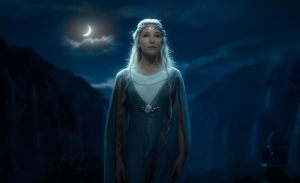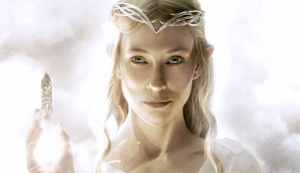 During my research for the previous article about Galadriel, I came across Anne C. Petty’s book One Ring to Bind Them All: Tolkien’s Mythology. There she states that Galadriel and Shelob are “both manifestations of the dread power of the female nature, yet binary opposites in Tolkien’s conception.” According to Petty, [Shelob] relies on the power of darkness for the purposes of malice, yet is as necessary to the balance of the natural world of Middle-earth as the elvish queen’s uplifting powers of light. […] The pitch of Shelob’s lair provides a direct contrast to the light of Galadriel […].” I will take this argument as a starting point when taking a closer look at Shelob in The Two Towers.
During my research for the previous article about Galadriel, I came across Anne C. Petty’s book One Ring to Bind Them All: Tolkien’s Mythology. There she states that Galadriel and Shelob are “both manifestations of the dread power of the female nature, yet binary opposites in Tolkien’s conception.” According to Petty, [Shelob] relies on the power of darkness for the purposes of malice, yet is as necessary to the balance of the natural world of Middle-earth as the elvish queen’s uplifting powers of light. […] The pitch of Shelob’s lair provides a direct contrast to the light of Galadriel […].” I will take this argument as a starting point when taking a closer look at Shelob in The Two Towers.
When Shelob is described in The Two Towers, the reader realises that she must be a terrible creature:
Great horns she had, and behind her short stark-like neck was her huge swollen body, a vast bloated bag, swaying and sagging between her her legs; its great bulk was black, blotched with livid marks, but the belly underneath was pale and luminous and gave forth a stench. Her legs were bent, with great knobbed joints high above her back, and hairs that stuck out like steel spines, and at each leg’s end there was a claw.”
In this passage, the narrator seems to play around with all those feature of spiders that are normally seen as frightening or creepy. Well, at least for people like me suffering from arachnophobia or people with a general dislike for spiders. Interestingly enough, ‘Shelob’ is a telling name. According to a letter written to his son Christopher in 1944, J.R.R. Tolkien explained that her name means “’she+lob’ (= spider),” in other words, ‘female spider.’ As most female spiders are larger than their male counterparts, it makes sense for Tolkien to make her a female.<
Even though Shelob appears to be, for the most part, just a nastier and bigger version of a normal spider, her eyes indicate that she is definitely not an ordinary spider: “Most like a spider she was, but huger than the great hunting beasts, and more terrible than they because of the evil purpose in her remorseless eyes” (TTT; “Shelob’s Lair”). Furthermore, the importance of Shelob’s eyes is reflected in the description of Galadriel’s eyes in “The Mirror of Galadriel”; FOTR: “[…] but no sign of age was upon [Galadriel and Celeborn], unless it were in the depths of their eyes; for these were keen as laces in the starlight, and yet profound, the wells of deep memory.” The eyes of both, Galadriel and Shelob, can be seen as the binary opposites as described by Petty.
Interestingly enough, even before Frodo and Sam get to see Shelob or Galadriel, they are being watched. After Gandalf has fallen into darkness, the Fellowship is making their way towards Lothlorien when they realize that they are being watched by Haldir and his brothers. Of course, Haldir is not Galadriel, but he is protecting her realm and she herself appears have the ability to see “from afar”: “Now tell us where [Gandalf] is; for I desired to speak with him again. But I cannot see him from afar […]” (“The Mirror of Galadriel”, FOTR). Similarly, Shelob could see Frodo and Sam long before they probably even realized they are being watched:
Not far down the tunnel, between them and the opening where they have reeled and stumbled, [Frodo] was aware of eyes growing visible, two great clusters of many-windowed eyes – the coming menace was unmasked at last” (“Shelob’s Lair”, TTT).
 The eyes are not to be the only thing that appears to be a binary opposite. Shelob’s Lair seems to be the exact opposite of Galadriel’s realm. Where the one place is light with a “gentle rain that fell at times, and passed away leaving all things fresh,” the other one is dark is filled with a “breathlessness of air.” However, in Shelob’s Lair as well as in Lothlorien, time seems to stop. In both places, those roaming inside lose the sense of time.
The eyes are not to be the only thing that appears to be a binary opposite. Shelob’s Lair seems to be the exact opposite of Galadriel’s realm. Where the one place is light with a “gentle rain that fell at times, and passed away leaving all things fresh,” the other one is dark is filled with a “breathlessness of air.” However, in Shelob’s Lair as well as in Lothlorien, time seems to stop. In both places, those roaming inside lose the sense of time.
Several times during their encounter with Shelob, Frodo as well as Sam are reminded of Galadriel and her Phial that was given to serve Frodo as a light in “dark places.” Interestingly enough, even Galadriel herself told Frodo to remember her: “[The Phial] will shine still brighter when night is about you. May it be a light to you in dark places, when all other lights go out. Remember Galadriel and her Mirror!”(“Farewell to Lorien”, FOTR).
While there are indeed many binary opposites between Galadriel and Shelob, both being ancient female characters with a “dread power of the female nature,” as mentioned by Perry, there are many dissimilarities as well. Furthermore, the relationship between Shelob and Sauron as well as the role of spider-like creatures like Shelob and Ungoliath in Middle-earth would be another interesting analysis. That will have to wait, however! Next time I want to talk about Arwen before moving onto The Silmarillion.



2 Comments